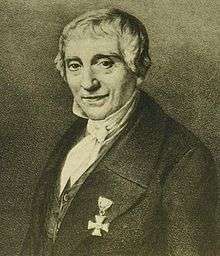Georg Friedrich Grotefend

Georg Friedrich Grotefend (9 June 1775 – 15 December 1853) was a German epigraphist and philologist. He is known mostly for his contributions toward the decipherment of cuneiform.
Life
He was born at Hann. Münden and died in Hanover. He was educated partly in his native town, partly at Ilfeld, where he remained till 1795, when he entered the university of Göttingen, and there became the friend of Heyne, Tychsen and Heeren. Heyne's recommendation procured for him an assistant mastership in the Göttingen gymnasium in 1797. While there he published his work De pasigraphia sive scriptura universali (1799), which led to his appointment in 1803 as prorector of the gymnasium of Frankfurt, and shortly afterwards as conrector. In 1821 he became director of the gymnasium at Hanover, a post which he retained till his retirement in 1849.
Work
Philology
Grotefend was best known during his lifetime as a Latin and Italian philologist, though the attention he paid to his own language is shown by his Anfangsgründe der deutschen Poesie, published in 1815, and his foundation of a society for investigating the German tongue in 1817. In 1823-1824 appeared his revised edition of Helfrich Bernhard Wenck's Latin grammar, in two volumes, followed by a smaller grammar for the use of schools in 1826; in 1835-1838 a systematic attempt to explain the fragmentary remains of the Umbrian dialect, entitled Rudimenta linguae Umbricae ex inscriptionibus antiquis enodata (in eight parts); and in 1839 a work of similar character upon Oscan (Rudimenta linguae Oscae). In the same year he published a memoir on the coins of Bactria, under the name of Die Münzen der griechischen, parthischen und indoskythischen Könige von Baktrien und den Ländern am Indus.
He soon, however, returned to his favourite subject, and brought out a work in five parts, Zur Geographie und Geschichte von Alt-Italien (1840-1842.). Previously, in 1836, he had written a preface to Friedrich Wagenfeld's translation of the Sanchoniathon of Philo of Byblos, which was alleged to have been discovered in the preceding year in the Portuguese convent of Santa Maria de Merinhão.
Cuneiform
But it was in the East rather than in the West that Grotefend did his greatest work. The cuneiform inscriptions of Persia had for some time been attracting attention in Europe; exact copies of them had been published by the Dutch artist Cornelis de Bruijn and the German traveller Niebuhr, who lost his eyesight over the work; and Grotefend's friend, Tychsen of Rostock, believed that he had ascertained the characters in the column, now known to be Persian, to be alphabetic.
At this point Grotefend took the matter up. His first discovery was communicated to the Royal Society of Göttingen in 1802,[1] and reviewed by Tychsen two years afterwards. In 1815 he gave an account of it in Heeren's work on ancient history,.[1][2] and in 1837 published his Neue Beiträge zur Erläuterung der persepolitanischen Keilschrift. Three years later appeared his Neue Beiträge zur Erläuterung der babylonischen Keilschrift. His discovery may be summed up as follows:
- that the Persian inscriptions contain three different forms of cuneiform writing, so that the decipherment of the one would give the key to the decipherment of the others
- that the characters of the Persian column are alphabetic and not syllabic
- confirmed Niebuhr's observation that they must be read from left to right
- that the alphabet consists of forty letters, including signs for long and short vowels
- that the Persepolitan inscriptions are written in Zend (which, however, is not the case), and must be ascribed to the age of the Achaemenian princes
- that a specific frequent word could refer to the Persian word for "king"
- that the inscriptions satisfy the two following schemes: A) X king, great king of king, son of Y king; B) Y king, great king of king, son of Z;
- that the presence of the two schemes A) and B) gives an opportunity to identify the people involved; it is necessary that X was a Persian king, his father was a Persian king too, but his grandfather was not king
- according to this idea Grotefend was able to identify X for Xerxes, Y for Darius and Z with Hystaspes.
A basis had now been laid for the interpretation of the Persian inscriptions. However,lacking knowledge of old Persian, Grotefend misconstrued several important characters. Significant work remained to be done to complete the decipherment. [3] Building on Grotefend's insights, this task was performed by Eugène Burnouf, Christian Lassen and Sir Henry Rawlinson. Interestingly, this work of Grotefend was spurred on by a simple bet which Grotefend made with a friend.
See also
- Friedrich August Grotefend, German philologist and relative of Georg Friedrich
- Champollion
Notes
- 1 2 Sayce, Rev. A. H., Professor of Assyriology, Oxford, "The Archaeology of the Cuneiform Inscriptions", Second Edition-revised, 1908, Society for Promoting Christian Knowledge, London, Brighton, New York; at pages 10-13 Not in copyright
- ↑ Heeren: "Ideen über die Politik, den Verkehr und den Handel der vornehmsten Volker der alten Welt", vol. i. pp. 563 seq., 1815, translated into English in 1833.
- ↑ Maurice Pope: "The Story of Decipherment", Thames and Hudson Ltd., London, 1975 and 1999, pp. 101-103.
References
-
 This article incorporates text from a publication now in the public domain: Chisholm, Hugh, ed. (1911). "Grotefend, Georg Friedrich". Encyclopædia Britannica (11th ed.). Cambridge University Press.
This article incorporates text from a publication now in the public domain: Chisholm, Hugh, ed. (1911). "Grotefend, Georg Friedrich". Encyclopædia Britannica (11th ed.). Cambridge University Press.
External links
![]() Media related to Georg Friedrich Grotefend at Wikimedia Commons
Media related to Georg Friedrich Grotefend at Wikimedia Commons